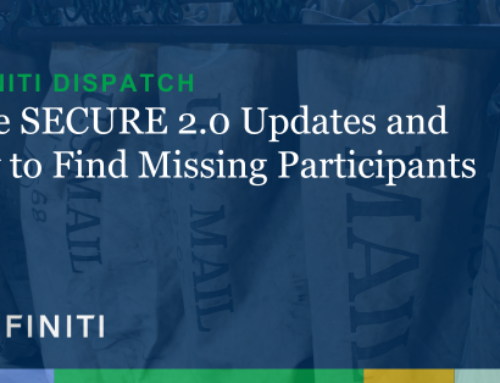VOL 8: AUDIT CHANGES
In July 2019, the American Institute of Certified Public Accountants (AICPA) Auditing Standards Board (ASB) issued SAS No. 136, which prescribes certain new performance requirements for an audit of financial statements of employee benefit plans subject to the Employee Retirement Income Security Act of 1974 (ERISA) and adjusts the form and content of the related auditor’s report. It should not be adapted for plans that are not subject to ERISA. Specifically, the SAS addressed the requirements for: (1) engagement acceptance, (2) audit risk assessment and response, including the auditor’s consideration of relevant plan provisions, (3) communications of reportable findings with those charged with governance, (4) the auditor’s responsibilities related to the ERISA-required supplemental schedules and the Form 5500, and (5) the form and content of the related auditor’s report.
ERISA Section 103(a)(3)(C) Audit
Hereafter, a “limited-scope audit” will be known as an ERISA Section 103(a)(3)(C) audit, which is unique to employee benefit plans and is not actually considered a scope limitation. From this type of audit, the report will offer a two-pronged opinion that is based on the audit and on the procedures performed relating to the certified investment information. It provides an opinion on whether the information not covered by the certification is presented fairly and an opinion on whether the certified investment information in the financial statements agrees with or is derived from the certification. When management elects to have an ERISA section 103(a) (3)(C) audit, the auditor is required to inquire of management about how it determined that the entity preparing and certifying the investment information is a qualified institution under DOL rules and regulations and evaluate management’s assessment of whether the institution is qualified. Starting with the audit report and financial statements prepared for periods ending on or after December 15, 2021, plan management will need to direct the auditor on whether the plan’s investment information is sufficient and can be relied on without the need for the institution’s statements to be audited in detail.
Plan Management Responsibilities
Under the new rules, Plan Sponsors will have new responsibilities. Plan management must provide to the auditor acknowledgements that plan management is responsible for:
- Determining whether a 103(a)(3)(C) audit is permissible and whether the certification meets ERISA requirements
- Maintaining and providing a current plan document
- Preparing and fairly presenting financial statements
- Providing a substantially completed (draft) Form 5500
Plan Sponsors will also be responsible for understanding which investments and disclosures are certified, and you will need to acknowledge, in writing, that all the conditions are met.
Suggested Steps for Plan Management
In light of the more demanding ERISA Section 103(a)(3)(C) audit requirements, plan management can take the following steps to meet these new expectations:
- Employ an auditor or auditing firm that can guide you in meeting these new standards successfully
- Maintain complete copies of the current plan document and the related financial statements in plan records
- Familiarize yourself what is considered a certified investment statement and the types of qualified institutions that are allowed to make the certification
- Verify that the certified investment information has been compared to other plan financial statements and supplemental information before being provided to the auditor
- Carefully review the annual Form 5500 draft to be sure it’s consistent with all other reporting and operation of the plan
- Incorporate these responsibilities and actions into the plan management committee meetings and document the process used to meet these responsibilities
- Start the plan audit as soon as practicable after the end of the plan year once the certified investment information is available
SAS No. 136 is effective for audits of financial statements for periods ending on or after December 15, 2020. Therefore, Plan Sponsors should be aware of the changes to the 2021 audit requirements for their plan and begin to implement the suggested steps as soon as possible.
—
 Brooke Cozort is an ERISA Attorney with significant experience working on ERISA matters and qualified plans. She provides guidance on plan design considerations, operational compliance, fiduciary responsibilities, legislative and regulatory changes and industry trends.
Brooke Cozort is an ERISA Attorney with significant experience working on ERISA matters and qualified plans. She provides guidance on plan design considerations, operational compliance, fiduciary responsibilities, legislative and regulatory changes and industry trends.
BROOKE K. COZORT, JD CPC
ERISA Attorney | brooke.cozort@definiti-llc.com
This material has been prepared for informational purposes only, and is not intended to provide legal, tax, or investment advice. Any tax-related discussion contained in this material is not intended or written to be used, and cannot be used, for (i) avoiding any tax penalties, or (ii) promoting, marketing, or recommending to any other party any transaction or matter addressed herein. This material does not provide fiduciary recommendations concerning investments or investment management; it is not individualized to the needs of any specific benefit plan or retirement investor, nor is it directed to any recipient in connection with a specific investment or investment management decision. Please consult your independent legal counsel and/or professional tax advisor regarding any legal or tax issues raised in this material.
—





